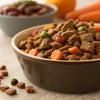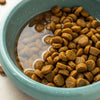Should I Feed My Dog Wet and Dry Food? A Comprehensive Guide for Pet Owners
- Houndsy
Table of Contents
- Introduction
- Understanding Wet and Dry Dog Food
- Benefits of Feeding Wet and Dry Food Together
- Considerations for Mixing Wet and Dry Food
- Practical Tips for Mixing Wet and Dry Dog Food
- Conclusion
Introduction
Did you know that nearly 70% of dog owners are unsure about the best feeding practices for their furry friends? With so many food options available, making the right choice can feel overwhelming. As loving pet parents, we want to ensure our dogs receive the best nutrition possible while also enjoying their meals. One of the most common questions we encounter is, “Should I feed my dog wet and dry food?” In this blog post, we’ll explore the benefits and drawbacks of both wet and dry dog food, how they can complement each other, and what factors to consider for your pet's unique needs.
By the end of this article, you will have a clear understanding of the nutritional benefits of wet and dry dog food, how to determine the right balance for your dog’s diet, and practical tips for mixing both types safely. We’ll also discuss how our flagship product, the Houndsy Kibble Dispenser, can enhance your dog feeding experience through convenience and design excellence.
So, let’s dive into the world of canine nutrition and discover how to elevate your dog's feeding ritual!
Understanding Wet and Dry Dog Food
Before we can address whether to feed your dog wet and dry food, it’s important to understand what each type of food entails.
What is Dry Dog Food?
Dry dog food, commonly referred to as kibble, is made from a combination of meat, grains, and vegetables. The ingredients are processed, cooked, and extruded into the familiar bite-sized pieces we see in pet stores. Here are some key characteristics of dry food:
- Low Moisture Content: Dry dog food typically contains less than 11% moisture, making it a concentrated source of nutrients.
- Long Shelf Life: Kibble has a longer shelf life compared to wet food, which makes it easier to store and manage.
- Dental Health Benefits: Chewing dry food can help reduce tartar build-up on your dog’s teeth, promoting better dental health.
What is Wet Dog Food?
Wet dog food, often found in cans or pouches, has a much higher moisture content, usually around 75-80%. It is made by cooking meat and other ingredients in a liquid form, which makes it more palatable for many dogs. Here are some notable aspects of wet food:
- Higher Moisture Content: The excessive moisture can help keep your dog hydrated, especially if they don’t drink enough water.
- Palatability: Wet food is often more aromatic and flavorful, making it appealing to picky eaters or dogs with decreased appetites.
- Easier to Chew: For dogs with dental issues or those that are older, wet food can be easier to consume.
Benefits of Feeding Wet and Dry Food Together
Combining wet and dry food can provide a balanced diet that meets your dog's nutritional needs while enhancing their eating experience. Here are some benefits of mixing both types:
Improved Hydration
For dogs that are not enthusiastic drinkers, the moisture from wet food can help increase their overall water intake. This is particularly beneficial for dogs with urinary or kidney issues.
Enhanced Flavor and Variety
Feeding a mix of wet and dry food can make mealtime more exciting. Dogs, much like us, can get bored with their food. A combination can add variety to their diet and entice even the pickiest eaters.
Nutritional Balance
By feeding both types of food, you can provide a well-rounded diet that includes the benefits of both wet and dry food. Dry kibble can help maintain dental health while wet food provides hydration and flavor.
Cost-Effective
Mixing wet food with dry food can enhance the flavor of the meal without relying solely on expensive wet food. Using less wet food in combination with dry can help manage costs while still making mealtime enjoyable for your pet.
Considerations for Mixing Wet and Dry Food
While there are several benefits to mixing wet and dry dog food, it’s essential to consider a few factors to ensure your dog's health and happiness.
1. Caloric Needs
Every dog has unique caloric requirements based on their age, weight, and activity level. Combining both types of food means you will need to monitor total caloric intake closely. Consulting with your veterinarian will help you determine the appropriate portions of wet and dry food for your dog.
2. Gradual Transition
If you plan to introduce wet food to your dog’s diet, do so gradually. Start by mixing a small amount of wet food with their dry food and slowly increase the proportion over several days. This helps prevent digestive upset and allows your dog to adjust to the new texture and flavor.
3. Storage and Freshness
Wet food must be stored properly after opening. It typically lasts only a few days in the refrigerator, while dry food can remain fresh for weeks if stored in an airtight container. Be mindful of the storage needs of both types of food to avoid waste.
4. Monitor Reactions
As with any dietary change, it’s crucial to monitor your dog's reactions. Look for any signs of digestive issues, allergies, or changes in appetite. If you notice anything concerning, consult your veterinarian.
Practical Tips for Mixing Wet and Dry Dog Food
Here are some helpful tips for successfully mixing wet and dry dog food:
Use a Reliable Measurement
To avoid overfeeding, always measure your dog’s food portions. Use a kitchen scale or measuring cup to ensure you’re providing the right amount of each type of food.
Consider Using a Kibble Dispenser
Our Houndsy Kibble Dispenser can elevate your feeding experience. With its convenient crank mechanism at standing height, it allows for easy portion control without bending. The dispenser holds a large capacity of 25-30 lbs, ensuring you always have kibble on hand while keeping it fresh with a BPA-free liner.
Create a Feeding Schedule
Establishing a regular feeding schedule can help regulate your dog’s appetite and digestion. This routine can also make it easier to monitor how much they eat and their overall health.
Mix It Up
To keep your dog interested in their meals, vary the combinations you offer. This can include different flavors of wet food or varying the amounts of wet to dry food.
Keep an Eye on Weight
Regularly check your dog’s weight to ensure they’re maintaining a healthy body condition. If you notice any significant changes in weight, consult your veterinarian for advice.
Conclusion
In answering the question, “Should I feed my dog wet and dry food?” it’s clear that both options offer unique benefits that can enhance your dog’s nutrition and overall well-being. By understanding the characteristics of wet and dry food and how they complement each other, you can create a balanced feeding routine that meets your dog's specific needs.
Remember to keep our Houndsy Kibble Dispenser in mind as you explore the best feeding options for your dog. With its modern design and ergonomic convenience, it’s an excellent tool for simplifying your dog’s feeding experience.
If you have any lingering questions or concerns about your dog’s diet, don’t hesitate to consult your veterinarian. A tailored feeding strategy can ensure your pup thrives and enjoys every meal.
FAQ
Can I mix wet and dry dog food every day?
Yes! Mixing wet and dry dog food daily can provide a balanced diet and keep mealtime exciting for your dog. Just be mindful of portion sizes to meet their caloric needs.
What if my dog doesn’t like wet food?
If your dog is hesitant to eat wet food, try gradually introducing it by mixing a small amount with their dry food. You can also experiment with different brands and flavors to find one that appeals to them.
How do I know how much to feed my dog?
Consult your veterinarian to determine your dog’s specific caloric needs based on their weight, age, and activity level. This will help you calculate the appropriate portions of wet and dry food to provide.
Is it safe to feed my dog only wet food?
Feeding your dog exclusively wet food is generally safe, but it may not provide the dental benefits associated with dry food. A combination of both can help maintain oral health while ensuring hydration.
How long can I keep opened wet dog food?
Once opened, wet dog food should be refrigerated and consumed within 3-5 days to ensure freshness and prevent spoilage. Always check the packaging for specific storage instructions.
By understanding your dog’s dietary needs and preferences, you can create a feeding routine that's not only nutritious but also enjoyable for your furry companion. Happy feeding!












